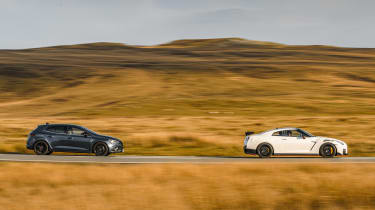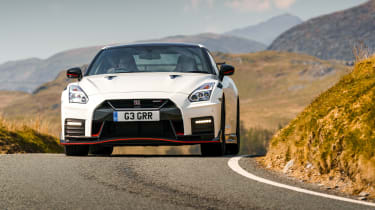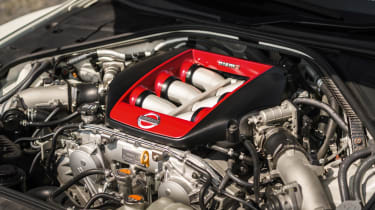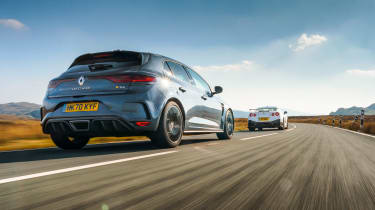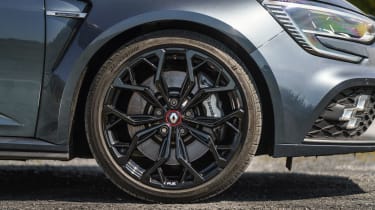Renault Mégane RS v Nissan GT-R Nismo – evo heroes fond farewell
Nissan's GT-R and the Mégane RS are two bona fide evo icons, but with both recently gone off sale we head out for one final drive and ask what's next.
'What’s it remapped to? I’m going for a thousand on mine next.’ Is this what life is like as a GT‑R driver? Either way, a truly melancholic moment has been shattered. Perhaps it’s for the best. Standing on Porthmadog beach, the sun dipping towards the scenery as it casts a golden glow over a pair of true evo heroes, I’d been in danger of becoming far too poetic. Luckily a clingy onlooker possessing both an open bottle of Smirnoff and a thick Yorkshire accent has stopped anyone getting too morose. Shaky phone videos of his heavily modified Nissan performing some questionable launches put paid to the seriousness of the occasion entirely.
Why are a thirty-grand Renault and a supercar-baiting Nismo having a romantic rendezvous, anyway? Well, both the Mégane RS and the GT‑R have recently left UK showrooms. For good, at least in any form we’ll truly recognise them in. Renault Sport has in fact ceased trading, though it’s mostly been a case of its engineers changing into Alpine fleeces and editing their email signatures. Nissan’s venerable super-coupe continues in production, but Britain is among a number of markets where looming regulations have euthanised its presence after a 14-year run. Yes, fourteen.
It’s a shame 2019’s mighty, track-focused Mégane 300 Trophy‑R wasn’t a run-out special for 2022; it might have lent this shoot some delightful colour-coded track-special symmetry. At the R’s launch, just a year after the base Mk4 Mégane RS had arrived, an engineer confided it was ‘now or never’ in terms of tightening rules. So what we’ve ended up with is a pair of cars in somewhat incongruous farewell costume. A mighty all-weather GT dressed as a slicks ‘n’ wings tribute act and a famously gnarly hot hatchback with its soft, non-Cup chassis and a paddleshift transmission, feeling like an order form gone wrong. If only on first acquaintance.
> Lamborghini Aventador SVJ v Nissan GT-R Nismo
The way these two cars’ lives have evolved and overlapped is fascinating. While fast Méganes have been knocking around for almost 20 years, Renault Sport’s middleweight really came of age in 2008 with the utterly heroic R26.R two-seat special. It finished fourth in that year’s eCoty, just shy of a podium topped by – rather neatly – the Nissan GT‑R, then a £52,900 car that’d torn our corner of the world asunder. Yeah, I just felt a bit light-headed too. The fact I’m ogling the last embers of daylight dance across a car more than three times the cost – while the Mégane peaked at an eye-watering £72,000 in Trophy‑R spec – opens up more questions than it answers. Ones we’re not here to address. We’re here, on our favourite stretches of Welsh tarmac (and sand), to celebrate two of the most evo cars of them all. We’re only an Elise and a GT3 short of a 3D mood-board for the entire magazine, really.
Let’s start with the GT‑R. No sports car made outside of Caterham or Malvern has evolved with such subtlety over the years. So while it’s sitting here with over 100bhp more than it launched with, the journey – punctuated by increasingly nerdy but decreasingly visible model-year updates – has felt barely perceptible. Not least because we’ve seen the Porsche 911, its route-one rival, go through three whole generations in that time, while further up the food chain Ferrari has launched the 458, 488 and F8. McLaren Automotive was a heritage company fiddling with old F1s when Nissan shocked the world with the new Skyline-that-wasn’t.
‘We arrived with the best car on the market and with such a package that we surprised everyone,’ says Arnaud Charpentier, Nissan’s European product marketing boss, ‘including us! We weren’t really aware what the team in Japan had been up to. It was an amazing gift and it contributed a lot to the brand image and reputation. If we come back with another, we need to surprise again. We can’t really compromise.’
It helps explain why an R36 still hasn’t popped up on the horizon. I’ve been lucky enough to put thousands of miles on GT‑Rs over the years, yet every single drive is still a lightning bolt through everyday life. Let’s shred the ‘it drives itself!’ rumour for good; no car is as uniquely belligerent about how it wants to make progress than an R35 GT‑R. It starts right from the off, as you shuffle its gear selector though a zig-zag pattern before its diffs clunk and moan as you pull away, wheels sporadically clawing for traction if you’ve parked on a loose surface. Like, y’know, a sandy beach.
The journey here was hardly a spa day either, the Nismo’s uprated suspension thumping loudly over the M6’s expansion joints before skipping petulantly over service station speed bumps. Its cold carbon-ceramics weren’t a bundle of fun when traffic randomly concertinaed past Birmingham, while any attempts at making calls on the move were rudely drowned out by tyre roar. Here’s a car that won’t suffer insouciance from its driver. Nor a lack of commitment; its transmission and ride are as fidgety as a toddler at a wedding ceremony when at low speeds. The kind of speeds Dean Smith loves taking photographs at…
Whenever he and his camera stop for a rest, though, I can indulge what the GT‑R really wants. The way it shoulders its way along the road inspires you to flex your own muscles, but if you loosen your grasp, relax into it, you can tease a real flow out of it. Which isn’t perhaps intuitive with the race-refugee spoiler dissecting your view in all three mirrors and shaking to a blur at speed on bumpier roads. On dry, warm tarmac the Dunlop Sport Maxxes – with a groove removed for the Nismo, to eke out another 11 per cent of contact patch – just never let go. It takes a wee while to build up faith in the front end, its light steering not initially giving oodles away, but take a leap of faith and you’ll realise it just grips. Always. There’s not a jot of understeer to be found at road speeds and while you can begin to lean on the rear, start to feel it push just a touch wider than the front as you loosen the ESC and bring a bit more of your own gumption, there’ll be big numbers on the digital readout before anything truly wild occurs.
You’ll be working its six-speed gearbox relatively hard in the process, too. Not a great deal happens below 3000rpm. It’s irritating that its bolshy looks seem to entice bored Insignia drivers like the Pied Piper, but it’s perhaps more irritating that if you’re just mooching along in D, you’ll not exactly outrun their turbodiesel torque. Told you it doesn’t like insouciance. Yep, for all its famed twin-turbocharging, it has a traditionally Japanese appetite for revs. And with appropriate use of its left paddle, you’ll stay ensconced in them for as long as you dare. Above 4000rpm it’s ballistic, a proper lit firework, though its sound is of a screaming metal gig beside the aria performed by the twin-turbo V6 in Ferrari’s latest baby supercar. Perhaps not worse for it, depending on your taste in music.
Its turbo lag acts as a welcome safety net. These felt like proper licence sponges when they launched, but the pace at which everything else has progressed – rivals whipped into shape by a car that simply hasn’t evolved at the same rate – does give some credence to visiting the aftermarket. Perhaps, as sales wind down and Nissan fails to immediately plug the large gap the 1.7-ton GT‑R leaves behind, tuning acts as an afterlife to keep the car relevant. For the first time, I get why it’s a path you might follow. Though I’d resist the vodka-addled video screenings.
Which isn’t to say it’s slow, simply that it’s wearing its years in a sports car market that’s soared past 800bhp with pointless ease. Even in its basic controls. Luddites will be delighted to learn there’s no stop/start, while if you pull a paddle in auto mode, the gearbox then stays resolutely manual, leading you to scream out of the next junction in first if you’re nonchalantly expecting it to shift back up on your behalf. It doesn’t allow you to let your guard down; it wants effort and concentration poured into its every aspect. It makes a Pista look like a pussycat. The end result may not be laugh-out-loud, but my word is it exhilarating when you and it are on song.
This example is very visibly wearing well over 18,000 miles, battle scars pockmarking its cartoonish body kit, its Alcantara wheel faded and the likely source of a curious smell pervading the cabin. It’s doubtless had a hard life as a press demonstrator, and nearly two years of sweaty palms and hastily eaten Ginsters has taken its toll. Luckily Jordan Katsianis is dispensing his shea butter hand cream like a department store sales assistant. He (and his fragrant palms) have covered a lot of those miles and we decompress together about what a loveably headstrong character this car has. A character that would be steamrollered by what’s the inevitable next step for the GT‑R – electrification – which would surely smooth out its charming low-speed fluster, be it in the form of hybridisation or full battery power. ‘It really feels like the end of a mechanical engineering mentality that only Japanese brands are able to pull off,’ says Jord.
Nissan itself appears conflicted over what should happen next to the company’s greatest asset, one that right now conflicts brutally with its drive towards electric cars. The Leaf is the second best-selling EV of all time, and a bruising V6 coupe that’s rarely the right side of 20mpg can only be a mischievous outlier beside it. Surely it’s an ominous sign that the similarly old-school 400Z isn’t coming to Europe.
Arnaud reckons the dawn of solid-state batteries towards the end of the decade will allow the GT‑R to flourish in a new, solely plug-in life, while the boss of Nissan’s Formula E team hopes the learnings of his single-seaters are paving a glorious path for electric performance cars. Nissan Europe’s powertrains boss, Matthew Wright, seems to have missed the memo. ‘I know in Japan they’re looking at how to electrify the GT‑R,’ he tells me, ‘but I don’t know how they’ll manage that. Honestly, I feel with the GT‑R that internal combustion is an inherent part of the car.’ The insular team responsible for Nissan’s halo car are – as ever – giving nothing away.
Internal combustion certainly won’t be an inherent part of the next quick Mégane we see. As Renault Sport morphs into Alpine, it’s also becoming a zero-emissions brand, the A110 and this fourth-gen Mégane its last bastions of petrol power. Reacquainting myself with a Mk4 comes with mixed feelings; after the exquisite Mk3, its arrival was as abrupt as Manchester United’s post-Fergie era, a barely faltering run of title wins brought to a clanging halt. Upon its launch, I refereed a hot hatch group test elsewhere and declared a French defeat with my heart shredded in two, still with vivid memories of evo’s Subaru BRZ cover test, which saw a beacon of affordable rear-driven light roundly extinguished by that month’s Mégane special. And to no one’s surprise.
Yet Alpine Cars MD Robert Bonetto reckons the Mk4 RS can be crowned as one of Renault Sport’s big achievements – and says it’s a sign of what to expect from the company’s self-proclaimed ‘dream garage’, comprising an Alpine 5 hot hatch, a quick crossover and an A110 replacement, all here by 2026.
‘The Mégane 4 gave more emotions to non-specialist drivers than we ever had before,’ he says. ‘These sensations were magnified by the Trophy‑R, but the versatility of the standard car shows the expertise of our team at being able to tune something in different ways for different versions. Alpine will do cars for specialists as well as people who aren’t. The A110’s agility does this well now; we don’t look for the best efficiency on track, it’s about cars that deliver the best emotions and are nicest to drive. That’s where we want to go.’
With that context, the Titanium Grey car here makes a whole heap of sense. And if you’ve a sense of déjà vu, that’s because it’s the car that recently departed evo’s Fast Fleet, back for a final testimonial appearance before the warm embrace of retirement. Mad £72k track toy aside, it’s the best Mk4 RS I’ve driven. I don’t remember them steering with this much clarity, but then I learned that John Barker, in a wonderfully John Barker moment, decided to research and fit new tyres (Bridgestone Potenza Sports) to tease the most involvement possible from its chassis. He’s only bloody nailed it.
Renault Sport never dabbled with adaptive damping, forcing you instead to make a permanent choice in the showroom. We’ve always defaulted to recommending the Cup chassis, but with the lattermost car’s newfound maturity, the base ‘Sport’ set-up nudges ahead. Nonetheless, it’s weird getting into a Mégane that feels so supple. Maybe I’ve matured, too, because I like it. And its gearbox. Though much as l’m enjoying its fluidity on these roads, I’m also craving the tension of Méganes past. Its civility is stark after the Nismo, so sophisticated at low speed it almost seems aloof about the art of going fast. It feels traditionally French in its bent towards comfort, in fact, arguably feeling just a little too closely aligned to any other Mégane. Versatility’s hardly sexy, is it?
Still, it’s a more cohesive package than the first Cup-chassised, manually shifted car I drove, albeit with a few shared qualms. You can’t decouple the exhaust and throttle maps in its drive modes, forcing you to endure childish pops and bangs if you want the components beneath you at their sharpest. But you can adjust the digital dials and mood lighting, thank god. The minor details feel oddly driver-unfocused for a Renault Sport, as do its half-height paddleshifters, which rarely seem to meet your fingertips, though the shift selector in the middle is hugely tactile for manual changes (an approach favoured by Mr GT3, Andreas Preuninger) and feels a nicer object to use than the awkward knob you found in manual Mk4s before a mid-life facelift ruled them extinct.
The gears themselves are delightfully short and punchy, too; the car upchanges for you in all but Race mode, but does it so high in the rev-range you’re unlikely to care. Grown-up it may be, but it’s not swotty like a VW Group hot hatch. Yet it still cruises at a relaxed two-thousand-odd revs on a motorway slog – strong given there’s no seventh gear, however much I keep reaching for one. Yep, this one’s showing its age in places too.
For all its newfound decorum, though, it’s still capable of delivering ‘the drive’. Every photoshoot has one, and almost always when you least expect it. Mine arrives not in the Nismo, but the humble hatch with precisely half the power. All fuelled-up at the end of the shoot, I lazily follow the nav towards a bunch of Welsh back-lanes that feel genuinely new to me. Dampers soaking everything up without fuss, and controversial 4Control four-wheel steer lending it a polite shove on the shoulder through trickier corners, I find a rhythm the GT‑R could never dream of on roads so modest.
Before long I’m extending a handful of the Mégane’s gears, even allowing myself to enjoy its childish cacophony on downshifts. I’ll admit it feels bizarre that there’s no limited-slip differential on the front – not only in the context of modern hot hatches, but Renault’s own recent history – and it’d be nice if the car’s aggressive corner entry was matched on exit. The LSD only came with the Cup pack, but with dry roads there’s never an ounce of clumsy wheelspin and it’d take a sodden day to make its absence a deal-breaker. I merge onto the A5 with half a mind to turn around and retrace my steps.
I choose to leave the memory untarnished, shifting the gearstick back across to auto and prodding everything into a less exuberant mode, those curvaceous rear arches lingering in the wing mirrors to remind me I’m in something special. Which, despite its flaws, this final iteration of Mégane still is. If any bunch of engineers can make a decent fist of plug-in performance, I suspect it’s those working on the successors to this departing pair. Perhaps there was no need for melancholy after all.
Specs
| Renault Mégane RS 300 | Nissan GT-R Nismo | |
| Engine | In-line 4-cyl, 1798cc, turbocharged | V6, 3799cc, twin-turbo |
| Power | 296bhp @ 6000rpm | 592bhp @ 6800rpm |
| Torque | 310lb ft @ 4000rpm | 481lb ft @ 3600-5800rpm |
| Weight | 1443kg | 1703kg |
| Power-to-weight | 209bhp/ton | 353bhp/ton |
| 0-62mph | 5.7sec | 2.8sec |
| Top speed | 158mph | 196mph |
| Basic price | £33,585 | £180,095 |
This story was first featured in evo issue 298.

